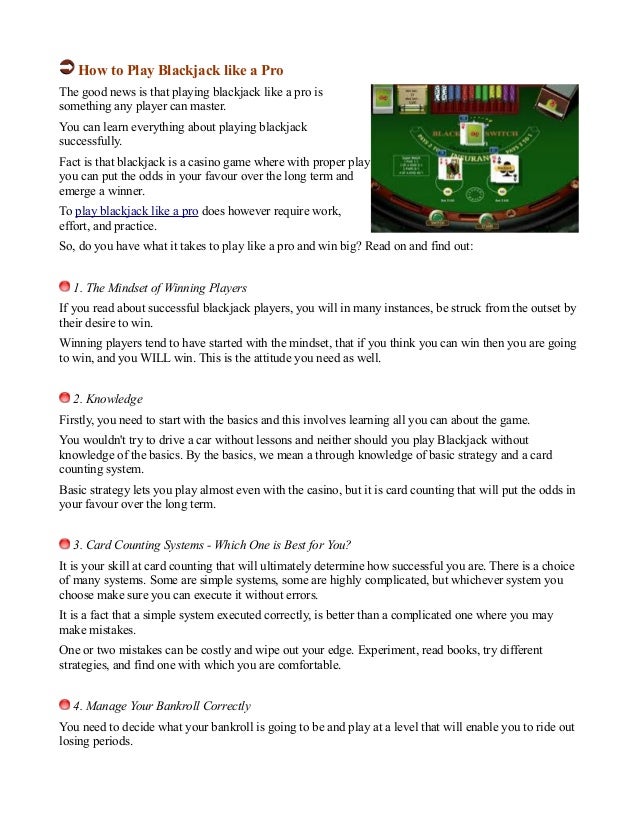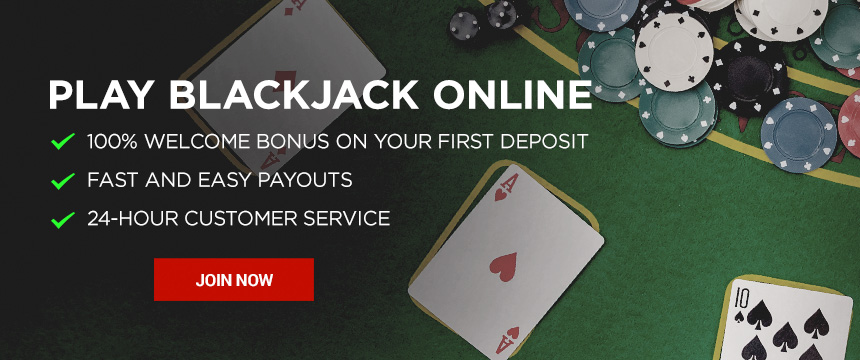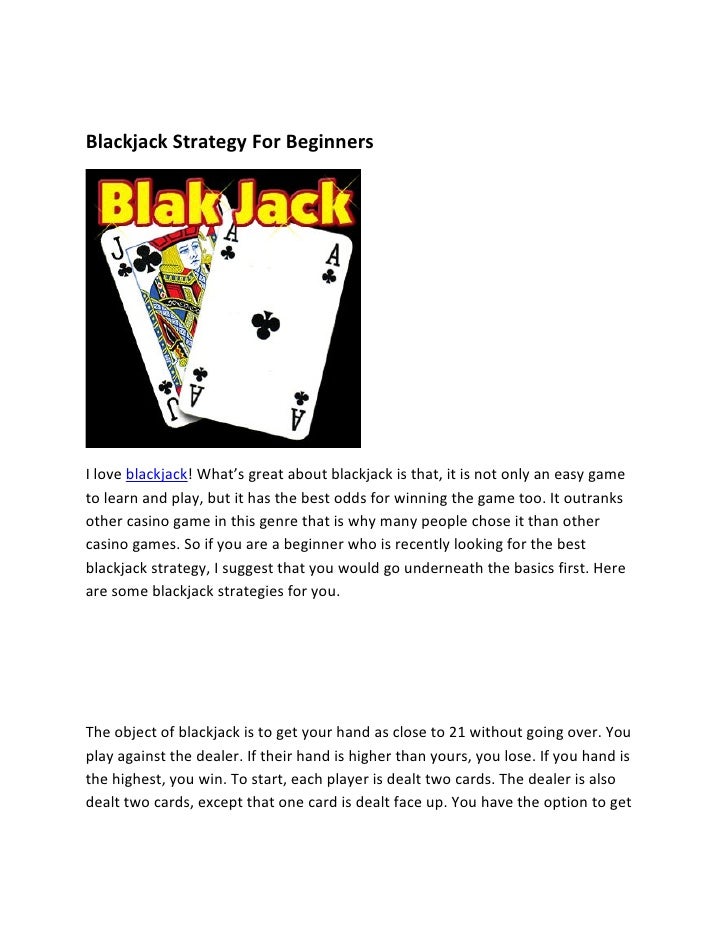Blackjack For Beginners
Preparing to Play Blackjack Finding a table: Strategic seating. Blackjack begins by selecting a seat at the table. Typically, a blackjack table. Purchasing chips. After you select your seat, you need to buy chips from the dealer. Select the amount of money you want. Homing in on house rules. In addition to the basic rules, more experienced players should also take note of the following advanced rules to take their blackjack game to the next level: Insurance - If a dealer shows an Ace as their face up card, they'll invite players to take insurance. This protects you. Surrendering - In.
A lot of blackjack tips pages don’t account for the skill level of the reader. You’ll find people suggesting that you learn to count cards or that you practice shuffle tracking.
The rules of blackjack are simple. You are dealt cards, which have the face value shown on them. You need to get a hand with a score of as close to 21 as possible, without going over it. Blackjack for Beginners: 7 Simple Tips and Tricks to Win Big Play Games With Liberal Playing Rules. Before you play, you need to scout some Blackjack tables and find the one with. Learn the Basic Playing Strategy. While learning blackjack for beginners, keep in mind that it isn’t a guessing game. How to Play Blackjack for Beginners Learning About Decks. When you play blackjack, it’s always best to start off with a simple variation of the game. The Easy Blackjack Rules to Follow. Blackjack is always played against the dealer. You’ll never play it against another.
This post consists of my seven best blackjack tips for beginners. To become a better blackjack player, keep reading below and start applying the following strategies and tips.
1. Master Basic Strategy
Honestly, if you ignored all the other tips on this list and just mastered basic strategy, you’d be way ahead of most other blackjack players.
What’s basic strategy? Well, it’s the mathematically optimal play in every blackjack situation.
You have the following information during each blackjack hand:
- You know what total you have.
- You know one of the dealer’s two cards.
How To Play Blackjack For Beginners Pdf
A basic strategy table compares your total with the dealer’s face-up card to give you the mathematically best play.
In some situations, the mathematically correct decision is the one that loses the least amount of money over time. In others, the mathematically correct decision is the one that wins the most money over time.
If you ignore basic strategy, you’re probably dealing with a house edge of 3% to 4%. That’s a lot of money to lose just because you didn’t want to memorize basic strategy.
You can find basic strategy tables on hundreds of sites on the internet, but you can also find text explanations for how to play each hand correctly. You can even buy a plastic laminated basic strategy card in the gift shop at the casino.
2. Never Take Insurance
The only time that taking insurance is mathematically correct is if you’re counting cards. Since this is a list of blackjack tips for the beginner, that doesn’t apply to you.
Insurance is a side bet that the dealer has a 10 in the hole. It pays off at 2:1. The casino calls it “even money,” but the truth is, the house has a high edge on the insurance bet.
Let’s assume you’re playing in a single-deck game, and the dealer has an ace showing. You have two cards, too, and neither of them is a 10. This means you have 49 cards that aren’t accounted for in the deck. Of those, 16 of them are worth 10—all the jacks, queens, kings, and 10s.So, you have 33 ways to lose the insurance bet compared to 16 ways to win. The bet pays off at 2:1, which is the same as 32:16. That’s one extra way that the casino has to win means that the casino has an edge, but how much of an edge?
Let’s say you bet $100 on insurance 49 times. You’d win $200 on 16 of those bets, for total winnings of $3,200. But you’d also lose $100 on 33 of those bets, for total losses of $,3300.
That’s a net loss of $100 on 49 bets, or an average loss of $2.04 per hand. This means the house edge for the insurance bet is at least 2.04%. And that edge goes up if you have a card worth 10 in your hand, because you have more ways to lose.
It’s crazy to make a bet with a house edge of 2% in a game where the house edge is only 0.5%. Insurance is a sucker bet. Just don’t take it.

3. Play in the Good Blackjack Games
The rules from one blackjack game to another vary. You should play in the game with the best rules you can find.
What kinds of rules variations should you look for?
- Probably the best variation is a game played from a single deck. Always find the game being dealt from the fewest number of decks.
- If you can find a single deck game or even a game dealt from two decks, go for that game (everything else being equal).
- Next, look for games where the dealer must stand on ANY total of 17. If the dealer hits a soft 17, the house edge goes up.

It’s beyond the scope of this post to cover all the possible rules variations, but those are two of the biggest to look for: the number of decks and whether the dealer hits a soft 17 or not.
4. Don’t Mess With Counting Cards
It isn’t as hard as you think to learn how to count cards, but if you’re a beginner, you should focus on mastering basic strategy. If you can’t play with perfect basic strategy on every hand, counting cards won’t help you much anyway.
The concept behind counting cards is probably easy to understand. The idea is that the ratio of high cards to low cards changes because of the random nature of the game. Sometimes, the remaining cards in the deck are mostly high cards, and sometimes they’re mostly low cards.
High cards are 10s and aces, and they’re important because they increase your probability of getting a natural.
What should you do if you have a better chance of getting a blackjack? Obviously, you should bet more.
But if you’re a beginner, focus on mastering basic strategy first. You can learn to count cards when you become an intermediate player.

5. Skip 6/5 Blackjack Games
A recent trend in Vegas blackjack is to offer games where the payoff for a natural is 6:5 instead of 3:2. Some casinos even brag about it as if it’s a boon to the player.
The idea is that six is a bigger number than three, so unsophisticated gamblers (beginners) will think 6/5 blackjack is a better deal. But it’s not.
Sure, you’ll only get a blackjack once out of every 20 hands or so, but why would you want to give up $30 per hand? That $30, averaged over 20 hands, is an additional loss of $1.50 per hand.
Let supply and demand send 6/5 blackjack to the graveyard where it belongs.
6. Skip Video Blackjack
Video blackjack games vary widely. Some of them only offer even-money payouts on a natural. Obviously, you should avoid those games.
Video blackjack games generally deal from eight decks that are shuffled after every hand. The rules are usually worse than the rules at any of the table versions of blackjack.
On top of all that, video blackjack is twice as fast as playing at a table with a dealer, which means you’ll put twice as much money into action per hour.
Suppose you see 100 hands of blackjack per hour at a standard table, and you play for $5 per hand. That’s $500 in action. With a house edge of 0.5%, the house expects to win $2.50 per hour from you.
Double the number of hands per hour on a video blackjack game, and even if you’re facing the same rules, you’ll lose $5 per hand.
Why lose more money per hour playing blackjack than you have to? Just say no to video blackjack.
7. Practice Online
One of the greatest things about the internet is the availability of free games at real money online casinos. Beginners can get a feel for how the actions work in a blackjack game without having to leave their homes or taking as much risk.
Of course, knowing how to double down and split will come in handy when you play for the first time in a live casino, too.
Conclusion
This page on blackjack tips for beginners was meant to offer advice specifically to those who are just getting started. That’s why I didn’t go into detail about how to count cards or about the specifics of basic strategy.
I hope you found it helpful. If you’d like to learn more about blackjack strategies and tips on how to become a better gambler, this site offers plenty of information for you to utilize. Good luck at the tables!
Blackjack is one of the most popular card games, second only to poker. Commonly referred to as 21, blackjack is a comparing game, meaning that each player competed against the dealer instead of against one another. It’s loved for its simplicity yet exciting level of play. The objective of blackjack is to get as close to 21 without exceeding this number.
Source: Wikimedia
The Basics of Rules of Blackjack
Blackjack can be played with 2-8 players (including the dealer) using a standard 52 pack of cards. Blackjack is played a little bit different in casinos than it is at home with your friends. The main difference is that a house dealer managers shuffling, dealing, and bets at a casino. This is referred to as a “permanent bank.” This contrasts a “changing bank” where each player is allowed the opportunity to be the dealer of cards. Additionally, casinos use a 6 pack totaling 312 cards.
Table Setup

Blackjack tables are shaped in a semi-circular configuration. This allows for easy facilitation of game play. Typically the green felt on the blackjack table will have a circular patch where you place your bet and a rectangular area where new deals are handed out to players. You can find a table for your game room by checking out this page. https://www.gametablesonline.com/gaming-tables/
Object of the Game
Blackjack For Beginners Free
The object of blackjack is to be the player with the highest score without going over 21. This is why blackjack is often called 21. Your number is calculated by adding up the numeric value of each card. Face cards include the King, Queen, and Jack and are given a value of 10. The ace has an optional value of 1 or 11 depending on how you wish to play the card. As you can imagine, this swing card can come in very handy. Blackjack occurs when your cards add up to exactly 21.
If you go over 21, you “bust” and you lose. Likewise, if the dealer’s card count exceeds 21, every player who has not gone over the limit will win no matter how small the hand. In the case where a player’s score is equal to that of the dealer, this is called a “push” and in effect, it is a draw. The player does not win or lose on a push.
The Shuffle, Cut, & Deal
Cards are shuffled until everything is mixed up very well. Then the dealer has another player “cut” the deck to ensure that the game is not rigged to give an advantage to the dealer or a player.
The dealer gives each player 2 cards, dealing cards in a clockwise rotation. Each player is dealt a single card face down. Once the first round has been dealt, the dealer places another card face up on top of the first card of each player. This allows players at the table to be able to know only one of the cards that opposing players have, making the game a bit more interesting.
Drawing
Once each player has been dealt their cards, they have the option to “hit” or “stay.” When you hit, you receive an additional card. If you feel confident in your hand, you choose to “stay” and receive no more cards. Remember, the name of the game is Twenty-One. You want to get as close to 21 without going over. The dealer must always “hit” until their card total is AT LEAST 17.
Blackjack For Beginners Videos
Whether you’re playing blackjack at home or at the casino, there are tons of strategies that you can play blackjack and win. Some people even teach themselves to count cards but that’s another topic for another post. If you’re learning how to play blackjack, you should start getting the hang of it after a few rounds. It’s really simple and straight forward.